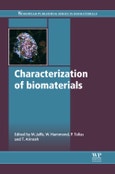Beginning with an introduction to microscopy techniques for analyzing the phase nature and morphology of biomaterials, Characterization of biomaterials goes on to discuss scattering techniques for structural analysis, quantitative assays for measuring cell adhesion, motility and differentiation, and the evaluation of cell infiltration and tissue formation using bioreactors. Further topics considered include studying molecular-scale protein-surface interactions in biomaterials, analysis of the cellular genome and abnormalities, and the use of microarrays to measure cellular changes induced by biomaterials. Finally, the book concludes by outlining standards and methods for assessing the safety and biocompatibility of biomaterials.
With its distinguished editors and international team of expert contributors, Characterization of biomaterials is an authoritative reference tool for all those involved in the development, production and application of biomaterials.
Table of Contents
Contributor contact details
Woodhead Publishing Series in Textiles
Chapter 1: Microscopy techniques for analyzing the phase nature and morphology of biomaterials
Abstract:
1 Introduction: basic imaging concepts
1.2 Image perception and interpretation
1.3 Light microscopy
1.4 Laser scanning confocal microscopy (LSCM)
1.5 Scanning electron microscopy (SEM)
1.6 Atomic force microscopy (AFM)
Chapter 2: Scattering techniques for structural analysis of biomaterials
Abstract:
2.1 Introduction
2.2 Light scattering
2.3 Wide-angle X-ray diffraction
2.4 Measuring orientation using X-ray diffraction
2.5 Small-angle scattering techniques
2.6 Small-angle X-ray scattering (SAXS)
2.7 Small-angle neutron scattering (SANS)
2.8 Acknowledgment
Chapter 3: Quantitative assays for measuring cell adhesion and motility in biomaterials
Abstract:
3.1 Introduction
3.2 Cell attachment assays
3.3 Cell adhesion strength
3.4 Collective motility of cell populations
3.5 Individual cell motility
3.6 Conclusion and future trends
Chapter 4: Assays for determining cell differentiation in biomaterials
Abstract:
4.1 Introduction
4.2 Deoxyribonucleic acid (DNA) and ribonucleic acid (RNA) assays
4.3 Protein and chemical assays
4.4 Imaging assays
4.5 Future trends
Chapter 5: Bioreactors for evaluating cell infiltration and tissue formation in biomaterials
Abstract:
5.1 Introduction
5.2 Bioreactor designs
5.3 Evaluation of cell infiltration and cell seeding
5.4 Evaluation of tissue formation
5.5 Importance of computational fluid mechanics in modeling, imaging, and simulation of the bioreactors
5.6 Failure of bioreactors
5.7 Future trends
5.8 Conclusion
5.9 Sources of further information and advice
Chapter 6: Studying molecular-scale proteinâ?"surface interactions in biomaterials
Abstract:
6.1 Introduction: surface-induced thrombosis on artificial surfaces
6.2 Process and changes during protein adsorption
6.3 Factors affecting protein adsorption
6.4 Models of protein adsorption and adsorption isotherms
6.5 Protein adsorption kinetics
6.6 The Vroman effect
6.7 Structure and functions of fibrinogen
6.8 Intermolecular forces and interactions
6.9 Adsorption profile and interfacial kinetics
6.10 Competitive adsorption
6.11 Atomic force microscopy (AFM)
6.12 Interfacial properties of fibrinogen studied by AFM
6.13 Future trends
6.14 Conclusion
Chapter 7: Assessing the mutagenic effects of biomaterials: analyzing the cellular genome and abnormalities
Abstract:
7.1 Introduction
7.2 DNA structure
7.3 Genetic mutations
7.4 Cytogenetic mutations
7.5 Types of mutations that can occur at the chromosomal level
7.6 Methods of detection of cytogenetic mutations
7.7 Analyzing genomic organization and variations in genomic copy number
7.8 Copy number variations (CNVs)
7.9 Epigenetic effects on the genome
7.10 Effects of biomaterials on mutagenesis
7.11 Conclusion
Chapter 8: Using microarrays to measure cellular changes induced by biomaterials
Abstract:
8.1 Introduction
8.2 What do we measure?
8.3 Normalization
8.4 Analysis
8.5 Conclusion
Chapter 9: Standards and methods for assessing the safety and biocompatibility of biomaterials
Abstract:
9.1 Introduction
9.2 Regulatory definition of medical devices
9.3 International Standards Organization (ISO) regulation and guidance
9.4 United States Food and Drug Administration (FDA) regulation and guidance
9.5 Regulation and guidance in Japan and other countries
9.6 Biological tests
9.7 Phasing (timing) of non-clinical testing of medical devices
Index








